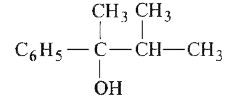The following reagent converts C6H5COCHO→C6H5CHOHCOONa
Aq. NaOH
Acidic Na2S2O3
Na2CrO4/H2SO4
NaNO2/HCl
The correct Answer is:A
To solve the question, we need to identify the reagent that converts benzaldehyde (C6H5CHO) to sodium benzoate (C6H5COONa). The reaction involves the addition of a reagent that facilitates this transformation.
1. Identify the Reactant: The starting compound is benzaldehyde, which has the formula C6H5CHO.
2. Identify the Product: The desired product is sodium benzoate, which has the formula C6H5COONa.
3. Determine the Reaction Type: The conversion of benzaldehyde to sodium benzoate suggests a reaction involving the formation of a carboxylic acid followed by neutralization with sodium hydroxide (NaOH).
4. Identify the Reagent: The reagent that can convert benzaldehyde to a carboxylic acid is typically an oxidizing agent. However, in this case, we are looking for a reagent that can facilitate the addition of a hydroxyl group (OH) to the carbonyl carbon of benzaldehyde.
5. Use of Sodium Hydroxide (NaOH): Aqueous sodium hydroxide (NaOH) can react with benzaldehyde in a reaction known as the aldol condensation or a similar reaction, leading to the formation of the corresponding sodium salt of the carboxylic acid.
6. Mechanism of Reaction:
- The hydroxide ion (OH-) from NaOH attacks the carbonyl carbon of benzaldehyde.
- This results in the formation of a tetrahedral intermediate.
- Subsequently, a rearrangement occurs, and water is eliminated, leading to the formation of the sodium salt of benzoic acid (C6H5COONa).
7. Final Product: The final product after the reaction is C6H5COONa, which is sodium benzoate.
Conclusion:
The reagent that converts C6H5CHO to C6H5COONa is aqueous sodium hydroxide (NaOH).
- The hydroxide ion (OH-) from NaOH attacks the carbonyl carbon of benzaldehyde.
- This results in the formation of a tetrahedral intermediate.
- Subsequently, a rearrangement occurs, and water is eliminated, leading to the formation of the sodium salt of benzoic acid (C6H5COONa).
The reagent that converts C6H5CHO to C6H5COONa is aqueous sodium hydroxide (NaOH).
Topper's Solved these Questions
- ALDEHYDES,KETONES & CARBOXYLIC ACIDS BOOK - VMC MODULES ENGLISHCHAPTER - ALDEHYDES,KETONES & CARBOXYLIC ACIDS EXERCISE - IN-CHAPTER EXERCISE-F
10 Videos
- ALDEHYDES,KETONES & CARBOXYLIC ACIDS BOOK - VMC MODULES ENGLISHCHAPTER - ALDEHYDES,KETONES & CARBOXYLIC ACIDS EXERCISE - IN-CHAPTER EXERCISE-G
10 Videos
- ALDEHYDES,KETONES & CARBOXYLIC ACIDS BOOK - VMC MODULES ENGLISHCHAPTER - ALDEHYDES,KETONES & CARBOXYLIC ACIDS EXERCISE - IN-CHAPTER EXERCISE-D
9 Videos
- ALCOHOLS, PHENOLS & ETHERSBOOK - VMC MODULES ENGLISHCHAPTER - ALCOHOLS, PHENOLS & ETHERSEXERCISE - Impeccable
100 Videos
- AMINESBOOK - VMC MODULES ENGLISHCHAPTER - AMINESEXERCISE - IN CHAPTER EXERCISE H
10 Videos
Similar Questions
Knowledge Check
Which set of the following reagents would you select to convert C6H5COCH3 (acetophenone) to the following alcohol ?
 ACH3CH2CH2MgBr and hydrolysisBCH3CH(Br)CH3⋅AlCl3C(CH3)2CHMgBr and acid hydrolysisDCH3CHCHCH3,Zn
ACH3CH2CH2MgBr and hydrolysisBCH3CH(Br)CH3⋅AlCl3C(CH3)2CHMgBr and acid hydrolysisDCH3CHCHCH3,ZnIdentify (A), (B) and (C ) in the following reaction sequence.
C6H5OH(A)−−→C6H6(B)−−→C6H5NO2(C)−−→AzobenzeneA(A) = Naoh = CaO, (B) = conc. H2SO4+ conc.HNO3,60−70∘C, (C) = glucose + NaOHB(A) = Zn power, (B) = conc. H2SO4 + Conc. HNO3,100∘C, (C) = NH4Cl+ZnC(A) = Zn, (B) = conc. H2SO4+ conc. HNO3,60−70∘C (C) = Zn + NaOHD(A) = NaOH + CaO, (B) = conc. HNO3 + conc. H2SO4, Reflux 24 hrs. (C) =CH3OH+Na
Complete the following equations:
C6H5COOH+SOCl2→
View SolutionHow many coulombs are required for the following reductions?
1 mol of C6H5NO2 to C6H5NH2
View SolutionComplete the following reaction :
C6H5Ona+C2H5CI→
View SolutionYou are provided with four reagents:
LiAIH4,I2/NaOH,NaHSO3 and Schiff's reagent.
Write which two reagents can be used to distinguish between the compounds in each of the following pairs:
C6H5COCH3 and C6H5COC6H5
View SolutionIUPAC Name of C6H5COC2H5
View SolutionIdentify the reagents A,B,C,D,E and F required for the following conversion: C6H5NO2A−−→C6H5NH2B−−→C6H5N2+Cl−C−−→C6H5ClDC6H5OHH2SO4−−−→E+F.
View Solution
